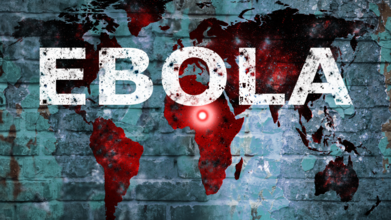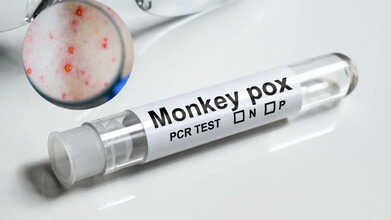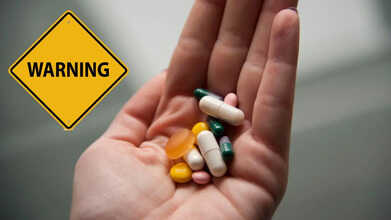- Health Conditions A-Z
- Health & Wellness
- Nutrition
- Fitness
- Health News
- Ayurveda
- Videos
- Medicine A-Z
- Parenting
- Web Stories
Ebola Outbreak Update: Vaccines Continue To Arrive As Congo Yet Again Becomes Disease Hotspot

Credits: Canva
Just 10 days after the Democratic Republic of the Congo (DRC) declared an Ebola virus outbreak in Kasai province, health authorities have rolled out a vaccination drive targeting frontline workers and contacts of patients, the World Health Organization (WHO) confirmed in its latest update.
First Vaccines Arrive in Bulape
The first consignment of 400 doses of Ervebo (VSV-EBOV) was dispatched to Bulape health zone from a national stockpile of 2,000 doses stored in Kinshasa. Some frontline health workers in the capital had already received the vaccine. The WHO said additional shipments are expected in the coming days to sustain the response effort.
Health teams are deploying a “ring vaccination” strategy, which prioritizes those at the highest risk of infection, including patient contacts and health workers directly exposed to cases.
Also Read: What Is Babesia That Could Block Your Lyme Disease Recovery?
Global Support for Vaccine Supply
To ensure adequate coverage, the International Coordinating Group on Vaccine Provision has approved an additional 45,000 doses to be sent to the DRC. The WHO is assisting the Ministry of Health in formalizing a request for these doses and has also worked with partners to draw up a detailed immunization plan. Training sessions for vaccination teams are underway to streamline the rollout.
Alongside vaccines, treatment options are being reinforced. Courses of the monoclonal antibody therapy MAb114 (ansuvimab-zykl, commercially known as Ebanga) have already been dispatched to treatment centers in Bulape to support patient care.
Rising Case Numbers and Death Toll
Despite these interventions, the outbreak continues to grow. At a meeting of the provincial Ebola emergency committee on September 13, officials reported a sharp increase in infections and fatalities. According to the DRC’s National Public Health Laboratory (INRB), total cases have now risen to 81, with 28 deaths recorded, marking a case-fatality rate of 34.6%.
The latest figures represent a significant jump from a few days earlier, when authorities reported 68 suspected cases (including 20 confirmed) and 16 deaths.
Also Read: Congo Ebola Outbreak Caused By The Zaire Strain So Far Has 28 Deaths, Confirms WHO
Of seven new suspected cases detected in the Bulape health zone, five have been confirmed through laboratory testing. This highlights both the rapid spread of the virus and the crucial role of diagnostic capacity in containing the outbreak.
Expanding Contact Tracing
Efforts to trace and monitor contacts are also being scaled up. Health officials identified 58 new contacts in recent days, bringing the total to 716. Contact tracing is a cornerstone of the response, enabling teams to vaccinate and monitor individuals most likely to have been exposed.
In a further boost to local capacity, another 360 vaccine doses have arrived in Tshikapa, the provincial capital of Kasai. This shipment is expected to support wider vaccination efforts in neighboring areas.
With Ebola continuing to claim lives in Kasai, health authorities in the DRC and their global partners are racing to contain the outbreak. Vaccines, therapeutic drugs, and intensive contact tracing remain at the heart of the strategy. However, the rising case count underscores the urgent need to maintain momentum and secure sufficient supplies before the virus spreads further.
WHO Warns Of Rising Mpox Cases As New ‘Clade Ib’ Strain Spreads Globally—See The List Of Affected Countries

Credits: CANVA
The World Health Organization (WHO) has raised concern over the continued spread of Mpox (formerly known as monkeypox) across Africa and other regions. In the past six weeks alone, 17 African nations have reported active transmission. Between September 14 and October 19, there were 2,862 confirmed infections and 17 related deaths, according to WHO’s 59th multi-country situation report released on October 30.
The Democratic Republic of Congo, Liberia, Kenya, and Ghana have reported the highest number of cases. Infections have increased notably in Kenya and Liberia, while the Democratic Republic of Congo has seen a slight decline and Ghana is beginning to show early signs of improvement.
What Is Mpox and How Does It Spread?
Mpox, previously known as monkeypox, is a viral infection caused by the monkeypox virus, which belongs to the Orthopoxvirus genus. The World Health Organization (WHO) identifies two main clades of the virus, Clade I (subdivided into Ia and Ib) and Clade II (IIa and IIb). The widespread outbreak seen during 2022–2023 was primarily linked to Clade IIb.
Typical symptoms include skin rashes or lesions that last two to four weeks, along with fever, body aches, swollen lymph nodes, fatigue, and headaches.
The infection spreads through close physical contact with an infected person, contaminated objects, or animals carrying the virus. Transmission from a pregnant woman to her baby can also occur.
How Serious Is the Global Mpox Situation Now?
According to the World Health Organization (WHO), a total of 42 countries reported 3,135 confirmed Mpox infections and 12 related deaths in September, with more than four-fifths of all cases recorded in Africa. While most regions have seen infection rates ease, the European and South-East Asian regions are now showing a slight increase.
The WHO stated that all variants, or clades, of the monkeypox virus (MPXV) remain in circulation worldwide. Experts caution that if emerging outbreaks are not swiftly controlled, ongoing community transmission may occur.
It is worth noting that in the same month, the WHO ended Mpox’s designation as a Public Health Emergency of International Concern (PHEIC) after observing a consistent decline in new infections, particularly in heavily affected African countries.
Where Has the New Clade Ib Variant Been Found?
The Clade Ib form of the Mpox virus has been newly detected in Malaysia, Namibia, the Netherlands, Portugal, and Spain. Additional imported cases linked to international travellers carrying the same strain have appeared in Belgium, Canada, Germany, Italy, Qatar, and Spain.
Evidence of local transmission—cases without any recent travel exposure, has been confirmed in six countries outside Africa: Italy, Malaysia, the Netherlands, Portugal, Spain, and the United States. In the U.S., three patients hospitalised in California tested positive for the new variant despite no travel history, according to The Guardian, prompting concern among health authorities.
Following these developments, WHO has officially classified these countries as experiencing community-level spread of the Clade Ib MPXV strain.
How Are Countries Responding to the Renewed Spread of Mpox?
WHO continues to assess the global Mpox threat as moderate among men who have sex with men (MSM) and low for the general population. The agency is encouraging governments to sustain surveillance systems, improve testing capabilities, and maintain access to vaccines and treatment options to prevent wider community outbreaks.
Blood Pressure Medication Recall 2025: Could Your Prescription Be on the FDA List?

Credits: CANVA
Medication recall blood pressure: More than 580,000 bottles of Prazosin Hydrochloride, a commonly prescribed drug for high blood pressure, are being recalled after tests showed potentially unsafe levels of a cancer-linked impurity. The manufacturer has advised patients using the affected medication to reach out to their doctor or pharmacist for guidance.
The recall, issued on October 7 by New Jersey–based Pharmaceuticals USA Inc., involves 55 batches of Prazosin Hydrochloride capsules distributed across the country. The recalled products were sold in 1 mg, 2 mg, and 5 mg doses under the Teva Pharmaceuticals label.
Below is the list of prescription numbers included in the FDA’s recall notice, along with medical advice on what steps to take if your medication is affected.
FDA gov blood pressure medication recall: Which Medicine Is Being Recalled?
Teva Pharmaceuticals USA and Amerisource Health Services have both recalled certain batches of prazosin hydrochloride this month after the U.S. Food and Drug Administration (FDA) detected possible contamination. According to FDA enforcement reports, the affected capsules may contain nitrosamine impurities that exceed the limits set under the agency’s Carcinogenic Potency Categorization Approach (CPCA).
Nitrosamines are a group of chemical compounds that, when present in high amounts, have been linked to an increased risk of cancer. They can form during the production or storage of certain medications.
The FDA classified these recalls as Class II on October 24, indicating that while the affected drugs could cause temporary or reversible health effects, the likelihood of severe harm is considered low.
Current Blood Pressure Medication Recall: Which Lot Are Affected?
The recall applies only to the 1 mg, 2 mg, and 5 mg capsules of prazosin hydrochloride distributed by Teva Pharmaceuticals USA and Amerisource Health Services. It affects select batches identified by specific lot numbers and expiration dates.
The majority of the recalled supply, over 580,000 bottles, came from Teva, with the remainder distributed by Amerisource. Details on the affected products, including the complete list of lot codes and expiry information, are available in the FDA’s official enforcement reports.
As reported by USA Today, the recall includes several dosages and packaging of the medication:
- 1 mg capsules: 181,659 bottles (NDC 0093-4067-01 and 0093-4067-10), from lot numbers 3010544A and 3010545A, with an expiration date of October 2025.
- 2 mg capsules: 291,512 bottles (NDC 0093-4068-01 and 0093-4068-10) from multiple lots, expiring between October 2025 and July 2026.
- 5 mg capsules: 107,673 bottles (NDC 0093-4069-01, 0093-4069-52, and 0093-4069-05) from several batches, with expiration dates extending into 2026.
What To Do If You Have The Recalled Blood Pressure Pills?
If you have any of the recalled prazosin hydrochloride capsules, the FDA recommends contacting your doctor or pharmacist before stopping the medication. In some cases, discontinuing treatment without medical supervision could pose greater health risks than continuing it.
Teva Pharmaceuticals has urged patients to check with their pharmacy to confirm whether their medication is part of the recall and to follow the instructions provided for returning or disposing of the affected pills. The company has already issued recall letters to its customers detailing the process.
Teva noted that no complaints have been reported so far related to the recalled batches. The company added that prazosin, which is used to manage high blood pressure, has several alternative treatments available. “Teva prioritizes patient safety and product quality at every stage of a medicine’s lifecycle,” the statement read.
Patients who have concerns or need further guidance are advised to speak with their prescribing healthcare provider.
Jesse Eisenberg Opens Up About Donating His Kidney to a Stranger; Understanding The Risks And Health Implications

(Credit-Golden Globes)
Jesse Eisenberg has opened up about his intention to donate his kidney to a stranger. He deemed the decision as a “no-brainer.” Known for films like Now You See Me, the 42-year-old actor shared the news on the Today show on October 30th, as he explained that he got the "blood donation bug" after participating in a blood drive over the summer.
Eisenberg stated he is scheduled for an altruistic donation, which is also known as a non-directed living donation, in mid-December. This means he is donating his organ to someone he does not know, with the recipient being selected based on medical compatibility.
Eisenberg stands by his decision, emphasizing, “It's essentially risk-free and so needed." He believes more people will realize "it's a no-brainer, if you have the time and the inclination.”
His reason for saying that donating his kidney is a ‘risk free’ decision is that, after this procedure, through the National Kidney Foundation's family voucher program, his family would be prioritized should if any of them ever need a living kidney donation in the future.
Donating a kidney can help improve the quality of life and survival for the receiver, however there are a few health implications one should keep in mind.
What Happens When You Do A Living Kidney Donation?
The American Kidney Fund explains that a living donation is a kidney transplant where a person who is alive and healthy gives one of their two healthy kidneys to a person with serious kidney disease. Kidneys that come from a living person usually work better and last longer than those that come from someone who has died. There are 2 types of kidney donations:
Non-directed Donation (Altruistic Donation)
This is when the person donating the kidney does not pick the recipient. Instead, they donate the kidney to a stranger. This is often done through a program that helps swap kidneys between people (a paired kidney exchange). Jesse Eisenberg is opting for this method.
Directed Donation
This is when the person donating the kidney chooses the specific person who will receive it, for example, a family member or a close friend.
Who Can Donate A Kidney, Are There Any Benefits?
To be able to donate a kidney while you are alive, you must meet a few requirements:
- You must be 18 years old or older.
- You must have two healthy, working kidneys.
- You must be healthy enough to handle the surgery and recovery.
Most people who donate a kidney can get back to their normal life in about two to four weeks. However, a team of doctors and nurses carefully checks the donor to make sure they understand all the possible physical, emotional, and financial risks.
- You help the person who receives your kidney to live longer and be healthier, and you may even save their life.
- The detailed check-up you go through helps you learn more about your own health.
What Are The Health Risks of Kidney Donation?
Like any surgery, kidney donation also carries physical risks. These can include common issues like pain at the surgical site, feeling weak and tired, or bloating. More serious, though less frequent, risks involve bleeding and the formation of blood clots, problems related to anesthesia such as pneumonia, a blocked bowel, and the possibility of infection. Additionally, donors will have a scar from the surgery and may feel sick to their stomach afterward.
The American Kidney Fund also explains that there may also be some emotional risks involved. Some people feel anxious, stressed, sad (depressed), or guilty if the kidney they gave doesn't work well for the recipient. It is a very noble task to help someone gain a second chance for a better life. Understanding the risks and health implications can help you make the most informed choice. Let your healthcare professionals know about your doubts and worries, as it will help them make the process better for you.
© 2024 Bennett, Coleman & Company Limited

